Introduction
The termite genus Kalotermes was first described and named by Hagen (1853) (Krishna et al. 2013). The type species for Kalotermes is Termes flavicolle Fabricius, a species that is now known as Kalotermes flavicollis (Fabricius) (Fabricius 1793; Krishna et al. 2013). Based on Krishna et al. (2013), there are a total of twenty living species and seven fossil species of Kalotermes that have been described.
Extant Kalotermes species are present in many areas within temperate and subtropical zones throughout the globe. These areas include, but are not limited to: Australia, Bermuda, the southeastern United States, Tasmania, New Zealand, South Africa, Algeria, Egypt, Greece, Syria, France, Italy, Israel, Portugal, Spain, Turkey, Chile, Peru, Madagascar, and Sri Lanka (Krishna et al. 2013). Among all extant and extinct species of Kalotermes, two species in particular have garnered more attention within entomological literature when compared to other Kalotermes species (Krishna et al. 2013). Those species are Kalotermes flavicollis and Kalotermes approximatus Snyder (Krishna et al. 2013).
Distribution and History
Kalotermes approximatus was first described and named by Snyder (1920) based on specimens collected in Ortega, Florida, on March 5th, 1919. To date, Kalotermes approximatus has been found within Florida, Georgia, Louisiana, Texas, Virginia, North Carolina, South Carolina, and Bermuda (Snyder 1925; Weesner 1965; Araujo 1977; Scheffrahn et al. 1988; Scheffrahn et al. 1994; Nalepa 1998; Hathorne et al. 2001; Scheffrahn et al. 2001; Krishna et al. 2013) (Figure 1). Within the United States, Kalotermes approximatus is the only Kalotermes species that has been described to date (Krishna et al. 2013).
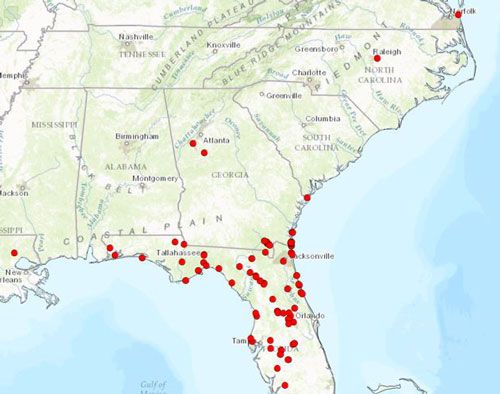
Credit: Rudolf H. Scheffrahn, data from University of Florida's termite collection
Within Florida, Kalotermes approximatus has been found in areas within central and northern Florida including but not limited to: Lake Kissimmee (Osceola County), Fruitland Park (Lake County), Gainesville (Alachua County), coastal Jacksonville (Duval County), and Tallahassee (Leon County) (Figure 2). Kalotermes approximatus may be undersampled within Florida and its overall range because of its low economic impact when compared to the economic impact of species such as Cryptotermes brevis (Walker) or Coptotermes formosanus Shiraki (Chouvenc et al. 2016).
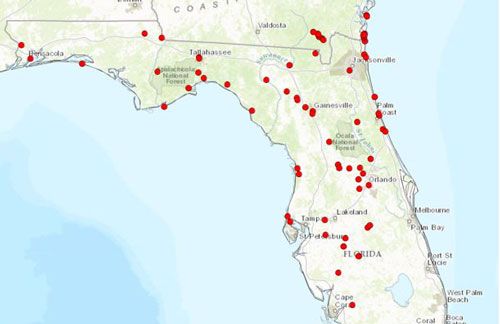
Credit: Rudolf H. Scheffrahn, data from University of Florida's termite collection
Identification
Soldiers
Similar to nearly all lower termite species, Kalotermes approximatus cannot be easily or reliably identified by examining members of the worker caste. Therefore, in order to identify Kalotermes approximatus, members of the soldier and/or reproductive caste must be examined.
Kalotermes approximatus soldiers are approximately 7.5 mm in length, described as medium-small size in comparison to other Kalotermitidae species present within their range, and exhibit morphological characters that are typically exhibited by species classified within Kalotermitidae (Snyder 1920; Scheffrahn and Su 1994). These characters are a pronotum that is as wide or wider than the head capsule, and two or more marginal teeth visible on the interior margin of the left mandible (Snyder 1920; Scheffrahn and Su 1994) (Figure 3).
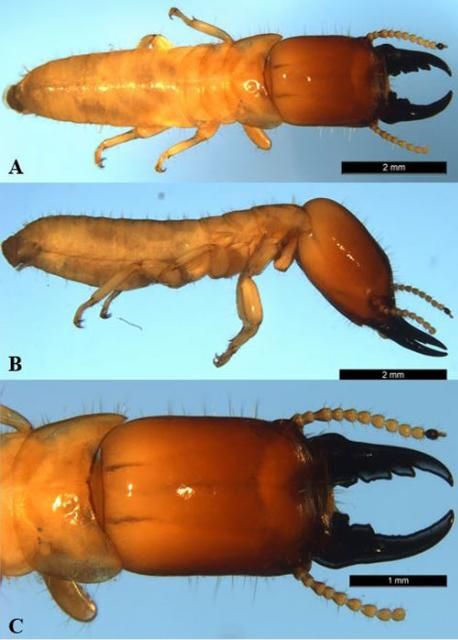
Credit: Joseph F. Velenovsky, University of Florida
Kalotermes approximatus soldiers also exhibit morphological characters that are not present in all Kalotermitidae species. These characters include a third antennal segment that is longer than the second antennal segment but not as long as the fourth and fifth antennal segments combined, a straight or nearly straight posterior margin of the pronotum, an anterior margin of the pronotum that is not incised, approximately thirteen to fifteen antennal segments, and distinct humps or bumps near the posterolateral base of each mandible (Snyder 1920; Snyder 1925; Scheffrahn and Su 1994). Figure 4 depicts a Kalotermes approximatus soldier alongside a Kalotermes flavicollis soldier for comparison.
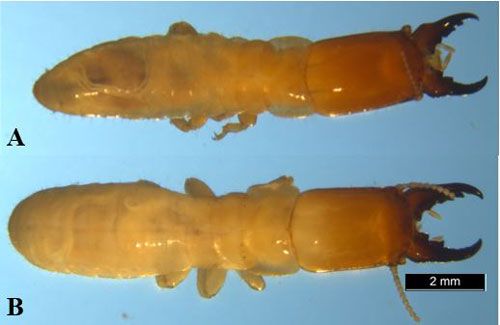
Credit: Joseph F. Velenovsky, University of Florida
Alates
Kalotermes approximatus alates are approximately 8.5–10 mm in length with wings included, described as medium size in comparison to other Kalotermitidae species within their range, and exhibit morphological characters that are typically exhibited by species classified within Kalotermitidae (Snyder 1925; Scheffrahn and Su 1994). These characters are three or more sclerotized veins visible in the costal margin, and multiple diagonal cross veins visible within the distal costal field (Snyder 1925; Scheffrahn and Su 1994) (Figure 5 and 8).
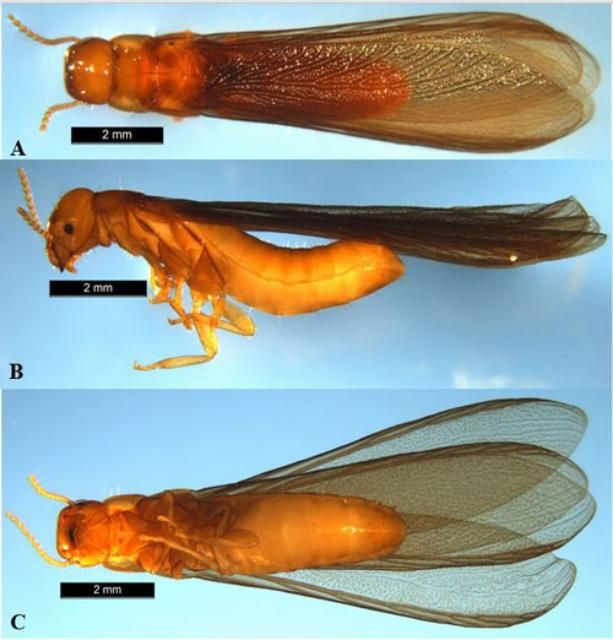
Credit: Joseph F. Velenovsky, University of Florida
Kalotermes approximatus alates also exhibit morphological characters that are not present in all Kalotermitidae species. These characters include the presence of an arolium between tarsal claws, head capsule setae that are longer than the diameter of the eye, approximately sixteen antennal segments, and limited cross veins that originate from the median vein (Snyder 1925; Scheffrahn and Su 1994) (Figure 6). Kalotermes approximatus alates may be reddish brown-dark reddish brown-black in coloration (Snyder 1925; Scheffrahn and Su 1994). Figure 7 depicts a Kalotermes approximatus alate alongside a Kalotermes flavicollis alate for comparison.
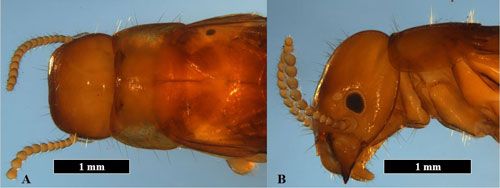
Credit: Joseph F. Velenovsky, University of Florida
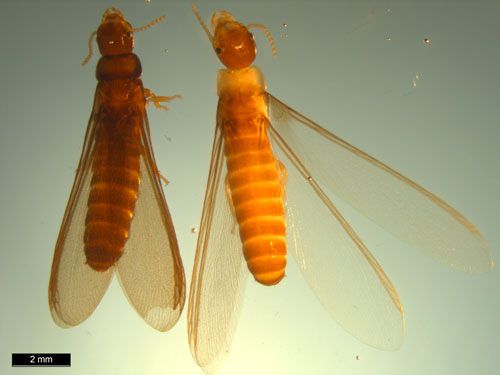
Credit: Joseph F. Velenovsky, University of Florida
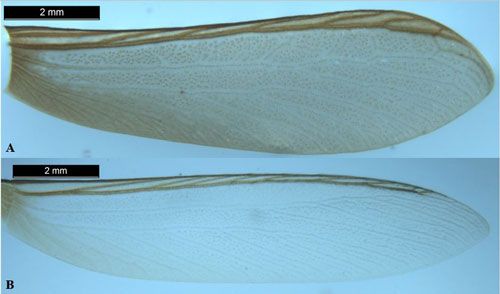
Credit: Joseph F. Velenovsky, University of Florida
Biology
Kalotermes approximatus, like all Kalotermitidae species, nest, feed, and live entirely within a single piece of wood (Eggleton 2011). In addition, similar to all Kalotermitidae species, Kalotermes approximatus colonies are composed of a reproductive caste (king, queen, and alates), a solider caste, and a pseudergate (i.e., worker) caste (Eggleton 2011). Kalotermes approximatus alates have been observed swarming during the day (diurnal flights) from September to November (Scheffrahn and Su 1994). A few publications have reported Kalotermes approximatus alates diurnally swarming during times other than September–November (Snyder 1925; Nalepa 1998). The observed variability in swarming season for Kalotermes approximatus may be reflective of undersampling and/or the different climatic conditions throughout its range. For more information on general drywood termite biology, please see Cryptotermes cavifrons Banks and Cryptotermes brevis (Walker).
Throughout its range, Kalotermes approximatus has been found within a variety of different tree species. Snyder in 1919 found Kalotermes approximatus within dead stumps of sweetgum trees (Liquidambar stryaciflua L.) located in Ortega, Florida (Snyder 1920). Additionally, in Florida, Kalotermes approximatus has been collected from a live black cherry tree (Prunus serotina Ehrh), a live pear tree (Pyrus communis L.), magnolia trees (Magnolia spp.), and oak trees (Quercus spp.) (Miller 1949; Hetrick 1961).
In North Carolina, Kalotermes approximatus has been found within the heartwood of a live red cedar tree (Juniperus virginia L.), a black walnut tree (Juglans nigra L.), a white oak tree (Quercus alba L.), an elm tree (Ulmus sp.), sweetgum trees, and magnolia trees (Syren and Luykx 1981; Nalepa 1998). Snyder 1924 reported Kalotermes approximatus within a dead bald cypress tree (Taxodium distichum L.) located in Cape Henry, Virginia.
In South Carolina, Kalotermes approximatus has been found within dogwood trees (Cornus spp.), a maple tree (Acer sp.), a water tupelo tree (Nyssa aquatica L.), a sweetgum tree, a water oak tree (Quercus nigra L.), a laurel oak tree (Quercus laurifolia Michx.), a southern live oak (Quercus virginiana Mill.), and a post oak (Quercus stellata Wangenh.) (Hathorne et al. 2001).
Kalotermes approximatus, similar to most if not all Kalotermes species, is thought to be a generalist feeder (R. H. Scheffrahn, pers. comm.; Nalepa 1998). The number of tree species in which Kalotermes approximatus has been found is likely reflective of its generalist feeding behavior, wide host range, and non-particularity in reference to host tree selection (R. H. Scheffrahn, pers. comm.; Nalepa 1998).
Pest Status
Kalotermes approximatus is classified as an uncommon structural pest, however, structural infestations of Kalotermes approximatus have been recorded within entomological literature (Scheffrahn and Su 1994; Potter 1997; Nalepa 1998). The uncommon structural pest status of Kalotermes approximatus may in part be explained by its higher moisture requirements relative to common drywood termite pest species such as Cryptotermes brevis (Collins 1969; Nalepa 1998). Active Kalotermes approximatus structural infestations should be contended with via standard drywood termite control methods. For more information on management of drywood termite structural infestations please see Cryptotermes cavifrons Banks and Cryptotermes brevis (Walker).
Selected References
Araujo RL. 1977. Catálogo dos Isoptera do Novo Mundo. Rio de Janeiro: Academia Brasileira de Ciências, 92 pp.
Chouvenc T, Scheffrahn RH, Su N-Y. 2016. "Establishment and spread of two invasive subterranean termite species (Coptotermes formosanus and C. gestroi; Isoptera: Rhinotermitidae) in metropolitan southeastern Florida (1990–2015)." Florida Entomologist 99(2): 187–191.
Collins MS. 1969. "Water relations in termites." Biology of Termites 1: 433–458.
Eggleton P. 2011. An introduction to termites: biology, taxonomy and functional morphology. In Biology of termites: a modern synthesis (pp. 1–26). Springer Netherlands.
Fabricius JC. 1793. Entomologia systematica emendata et aucta. Secundum: classes, ordines, genera, species. adjectis: synonimis, locis, observationibus, descriptionibus. Vol. 2. Hafniae [Copenhagen]: Christ. Gottl. proft, viii + 519 pp.
Hagen HA. 1853. Hr. peters Berichtete über die von ihm gesammelten und von Hrn. Dr. Hermann Hagen bearbeiteten Neuropteren aus Mossambique. Bericht über die zur Bekanntmachung Geeigneten Verhandlungen der Königlichen preussischen Akademie der Wissenschaften zu Berlin 18: 479–484.
Hathorne KT, Zungoli PA, Benson EP, Bridges WC. 2001. "Kalotermes approximatus habitat in South Carolina." Florida Entomologist 84(4): 712–715.
Hetrick LA. 1961. "Kalotermes approximatus Snyder infests roseaceous trees (Isoptera: Kalotermitidae)." Florida Entomologist 44: 53–54.
Krishna K, Grimaldi DA, Krishna V, Engel MS. 2013. Treatise on the Isoptera of the World, Volume 2. Basal Families. Bulletin of the American Museum of Natural History 377: 205–621.
Miller EM. 1949. A handbook on Florida termites. Coral Gables, Florida: University of Miami press, 30 pp.
Nalepa CA. 1998. "Distribution of Kalotermes approximatus (Isoptera: Kalotermitidae) in North Carolina." Florida Entomologist 81(2): 251–254.
Potter MF. 1997. Termites, pp. 233-333. In Mallis, A Handbook of Pest Control. 8th edition. Mallis Handbook and Technical Training Co., Cleveland, OH. 1456 pp.
Scheffrahn RH, Mangold JR, Su N-Y. 1988. "A survey of structure-infesting termites of peninsular Florida." Florida Entomologist 71(4): 615–630.
Scheffrahn RH, Su N-Y. 1994. "Keys to soldier and winged adult termites (Isoptera) of Florida." Florida Entomologist 77(4): 460–474.
Scheffrahn RH, Su N-Y, Chase JA, Forschler BT. 2001. "New termite (Isoptera: Kalotermitidae, Rhinotermitidae) records from Georgia." Journal of Entomological Science 36(2): 109–113.
Snyder TE. 1920. Kalotermes approximatus, new species. In N. Banks and T.E. Snyder. A revision of the Nearctic termites [Banks], with notes on the biology and distribution of termites [Snyder]: 22. United States National Museum Bulletin 108: [i]-viii + 1-228 + 35 pls.
Snyder TE. 1924. "A non-subterranean termite in Virginia." Proceedings of the Entomological Society of Washington 26(8): 207–209.
Snyder TE. 1925. "Description of winged adult of Kalotermes approximatus Snyder." Proceedings of the Entomological Society of Washington 27(1): 14.
Syren RM, Luykx P. 1981. "Geographic variation of sex-linked translocation heterozygosity in the termite Kalotermes approximatus Snyder (Insecta: Isoptera)." Chromosoma (Berlin) 82: 65–88.
Weesner FM. 1965. Termites of the United States: a handbook. Elizabeth, NJ: National pest Control Association, 70 pp.